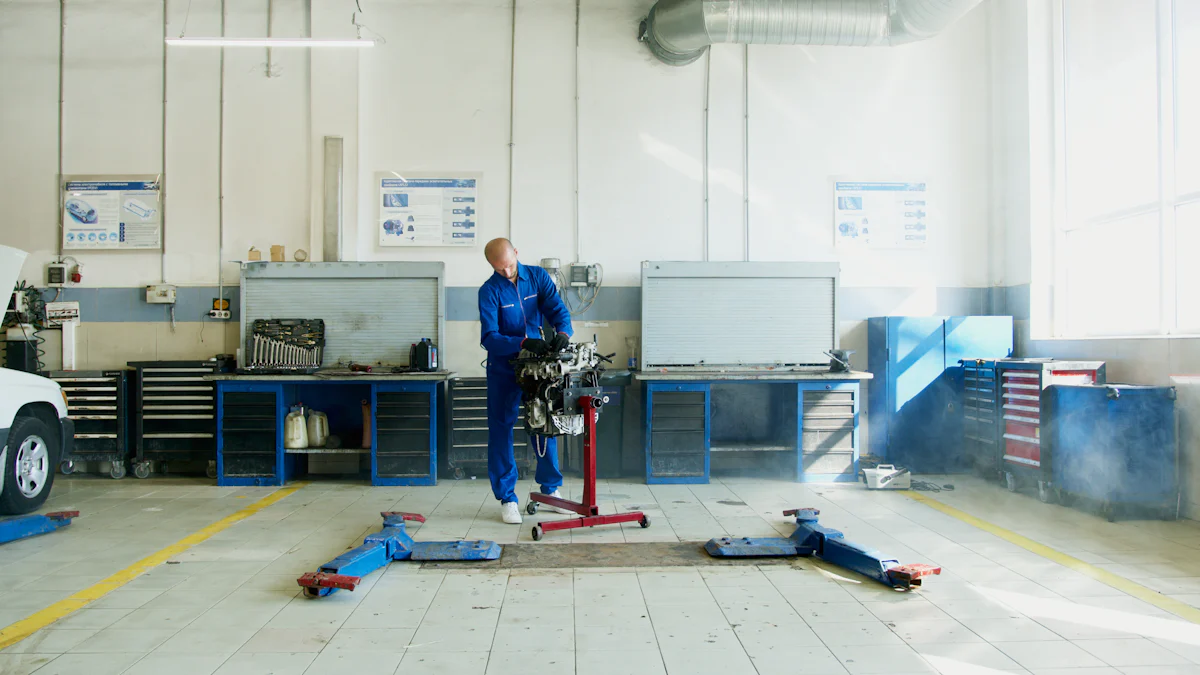
Regular maintenance of pallet carts is crucial for ensuring safety, productivity, and equipment longevity. By servicing your Pallet Jacks regularly, you not only protect operators and enhance efficiency but also extend the lifespan of the equipment. Here, you will discover essential tips for maintaining pallet carts effectively, reducing wear on parts, minimizing repairs, and safeguarding operator health.
Inspect and Repair Damages

Regular Inspections
Regular inspections play a vital role in maintaining the pallet cart. By conducting regular inspections, potential issues can be identified early, preventing major malfunctions and costly repairs down the line. It ensures that the Pallet Jacks are in optimal condition for safe and efficient operation.
Checking Wheels and Casters
Checking the wheels and casters is a fundamental aspect of regular maintenance. This step involves inspecting each wheel and caster thoroughly to ensure they are free from damage or excessive wear. By checking for any signs of wear or misalignment, operators can address these issues promptly, enhancing the longevity of the equipment.
Examining Structural Components
Another crucial part of regular inspections is examining the structural components of the pallet cart. This includes assessing the frame, handles, and other structural elements for any signs of damage or weakness. By identifying and addressing these issues during routine inspections, operators can maintain the structural integrity of the Pallet Jacks.
Performing Repairs
Performing timely repairs is essential to keep the pallet cart functioning optimally. Addressing any damages or wear promptly can prevent further deterioration and ensure that the equipment remains safe to use.
Replacing Damaged Parts
When conducting maintenance on Pallet Jacks, it is important to replace any damaged parts as soon as possible. Whether it’s a worn-out wheel or a cracked handle, replacing damaged components promptly can prevent more extensive issues in the future.
Ensuring Structural Integrity
Maintaining the structural integrity of the pallet cart is crucial for its overall performance and safety. By ensuring that all structural components are in good condition, operators can prevent accidents and prolong the lifespan of their equipment.
By following these essential tips for inspecting and repairing damages on your Pallet Jacks, you can ensure that your equipment operates smoothly, safely, and efficiently.
Lubricate Moving Parts
Importance of Lubrication
Reducing Friction
Lubrication plays a crucial role in reducing friction between moving parts of pallet carts. By applying lubricants to axles and joints, operators can minimize the resistance encountered during operation, leading to smoother movements and less strain on the equipment.
Extending Lifespan
Proper lubrication not only reduces wear and tear on pallet jacks but also extends their lifespan significantly. By regularly lubricating key components, such as axles and joints, operators can prevent premature deterioration and ensure the longevity of the equipment.
Preventing Rust
One of the key benefits of lubrication is its ability to prevent rust formation on metal parts. By creating a protective barrier against moisture and corrosion, lubricants help maintain the structural integrity of pallet carts, especially in humid or damp environments.
Types of Lubricants
Choosing the Right Type
Selecting the appropriate type of lubricant is essential for effective maintenance. Different types of lubricants, such as grease or oil-based solutions, offer unique properties suited for specific applications. Operators should refer to manufacturer guidelines to determine the most suitable option for their pallet jacks.
Ensuring Compatibility
When choosing lubricants for pallet carts, it is crucial to ensure compatibility with materials used in construction. Using incompatible lubricants can lead to damage or degradation of components over time. Operators should verify that the selected lubricant is safe for use on all parts of the equipment.
Frequency of Application
The frequency of lubrication application depends on various factors, including usage intensity and environmental conditions. Regularly inspecting axles and joints for signs of dryness or friction can help determine when reapplication is necessary. Maintaining a consistent lubrication schedule is key to optimal performance and longevity.
By understanding the importance of proper lubrication in maintaining pallet jacks and selecting the right type of lubricant based on manufacturer recommendations, operators can enhance equipment performance, prevent premature wear, and prolong the lifespan of their valuable assets.
Clean Regularly
Cleaning Techniques
Regular maintenance of pallet carts involves cleaning to ensure optimal performance and longevity. By implementing effective cleaning techniques, operators can prevent the buildup of debris and contaminants that may compromise the functionality of their Pallet Jacks.
Removing Debris
Removing debris from the pallet cart is a crucial step in the cleaning process. Operators should regularly inspect and clear any dirt, dust, or loose particles that accumulate on the equipment. This simple task helps prevent blockages and ensures smooth operation during material handling tasks.
Cleaning Dirt and Contaminants
In addition to removing visible debris, operators must address dirt and contaminants that can affect the cleanliness of Pallet Jacks. Using appropriate cleaning solutions and tools, such as brushes or wipes, allows for thorough removal of dirt and grime from various surfaces. By maintaining a clean environment, operators can prolong the lifespan of their equipment.
Cleaning Schedule
Establishing a consistent cleaning schedule is essential for maintaining the cleanliness and functionality of pallet carts. By incorporating daily and deep cleaning routines into their maintenance practices, operators can ensure that their Pallet Jacks remain in top condition for optimal performance.
Daily Cleaning
Daily cleaning tasks involve quick inspections and spot-cleaning to address immediate issues. Operators should wipe down handles, frames, and wheels to remove surface dirt or spills that may hinder operations. This regular upkeep prevents the accumulation of debris and promotes a safe working environment.
Deep Cleaning
Periodic deep cleaning sessions are necessary to tackle more stubborn dirt or contaminants on Pallet Jacks. During deep cleaning, operators should disassemble components for thorough inspection and cleansing. This process allows for detailed maintenance, including lubrication of moving parts and inspection of structural integrity.
By adhering to a regular cleaning schedule that includes both daily upkeep and deep cleaning sessions, operators can ensure that their pallet carts are well-maintained and ready for efficient material handling tasks.
Tighten Loose Components
Identifying Loose Parts
Bolts and Nuts
When inspecting pallet carts for maintenance, operators should pay close attention to bolts and nuts. These essential components play a crucial role in the structural integrity of the equipment. Loose bolts and nuts can lead to instability and compromise the safety of Pallet Jacks during material handling tasks.
Fasteners
Another key aspect of identifying loose parts is examining fasteners. Fasteners such as screws, rivets, or clips are used to secure various components of the pallet cart together. Loose fasteners can result in rattling noises, wobbling structures, or even detachment of critical parts. Regular inspection is necessary to ensure that all fasteners are securely tightened.
Tightening Process
Tools Required
To address loose components effectively, operators need the appropriate tools for tightening. Utilizing tools such as stubby slotted screwdrivers, nutdriver blades in various sizes (1/4″, 9/32″, 1/2″, etc.), Phillips screwdrivers, Allen hex blades, and slot screwdrivers is essential for proper maintenance.
Ensuring Stability
Ensuring stability through a systematic tightening process is vital for maintaining the functionality and safety of Pallet Jacks. By using suitable tools like nutdriver blades or screwdrivers, operators can tighten loose bolts, nuts, and fasteners securely. This process prevents potential accidents caused by unstable components during material transport tasks.
By diligently identifying and tightening loose parts with the appropriate tools, operators can enhance the structural stability and safety of their pallet carts, ensuring smooth operations and minimizing risks associated with loose components.
Check Load Capacity
When it comes to pallet carts and Pallet Jacks, understanding the load capacity is paramount for ensuring safe and efficient operations. The load capacity refers to the maximum allowable force that these equipment can withstand under specific conditions. This knowledge is essential in preventing overloading, which can lead to failures and compromise safety.
Importance of Load Limits
Preventing Overloading
One crucial aspect of checking the load capacity is to prevent overloading. Overloading a pallet cart or a Pallet Jack can have detrimental effects on the equipment, such as severe damage to the wheels and an imbalance in weight distribution. By adhering to the specified load limits, operators can avoid these issues and maintain the longevity and performance of their equipment.
Ensuring Safety
Ensuring safety is another key reason for inspecting and adhering to load limits. Exceeding the recommended weight capacity poses risks not only to the equipment but also to operators handling the pallet carts. By staying within the designated load limits, operators create a safer working environment and reduce the chances of accidents or injuries.
Load Capacity Inspection
Checking Weight Limits
During maintenance routines, it is essential to conduct thorough inspections of the weight limits for pallet carts. Understanding both static and dynamic load capacities is crucial, with dynamic load capacity often being lower due to peak stresses during operation. By checking weight limits regularly, operators can ensure that they do not exceed the maximum dynamic load capacity, thus preventing failures.
Adjusting Loads
Adjusting loads based on weight capacities is necessary for safe material handling tasks. When ordering new pallets or planning material transport, considering load ratings—including static and dynamic load capacities—is vital. This understanding helps in selecting appropriate pallets for different weight concerns and contexts, ensuring optimal performance without compromising safety.
Regular maintenance of pallet carts, such as the Manual Pallet Jack by Zoomsunmhe, is a prudent investment for businesses seeking to optimize resources and prioritize staff safety. By implementing a comprehensive servicing routine, companies can prolong equipment lifespan, prevent costly breakdowns, and ensure operational efficiency. Scheduled maintenance not only minimizes downtime and energy consumption but also reduces the risk of major repairs or replacements. Emphasizing the benefits of regular servicing, including increased productivity and prolonged equipment longevity, encourages businesses to prioritize maintenance as a cost-effective measure in the long run.
Post time: May-30-2024
